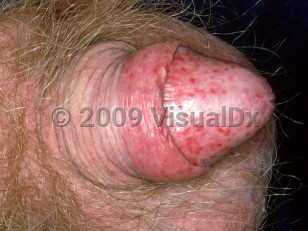Balanoposthitis - Anogenital in
Alerts and Notices
Important News & Links
Synopsis

Balanoposthitis is usually classified based on etiology: infectious, traumatic, allergic, irritant, and nonspecific. The presenting symptoms may include genital pain and/or tenderness, dysuria, groin rash, swelling and redness of the foreskin and glans, inguinal lymphadenopathy, and possibly pruritus. A foul-smelling, purulent discharge from the foreskin, but not the urethra, may be present. Urinary retention can be seen in more severe cases. In more chronic cases, scarring between the prepuce and glans may be present with or without meatal stenosis and/or phimosis.
Balanoposthitis is a clinical diagnosis, with laboratory data and patient history used to help determine etiology, which will then guide treatment.
In young, diapered infants, it is commonly caused by Candida albicans and is seen in association with diaper dermatitis. Irritant causes are also common in this age range and may result from poor hygiene or forced foreskin retraction. Escherichia coli is the most common bacterial cause in this age range.
In prepubertal boys, nonspecific balanoposthitis is most common, usually as a result of poor hygiene. Group A streptococcal balanoposthitis must be considered and may be seen in association with group A streptococcal infection in other parts of the body, including pharyngitis, impetigo, and perianal infections. Staphylococcus aureus is another common bacterial cause. Irritant and traumatic etiologies are also common in this age range.
In pubertal adolescent males, the etiologies are more diverse. Common infectious causes include Gardnerella and anaerobic infections with Bacteroides spp. Other infectious etiologies include chlamydial and gonococcal infections, group B Streptococcus, and mixed anaerobic infections. Chemical, irritant, and allergic reactions to condoms, spermicides, and lubricants must also be considered. Poor hygiene and other irritant etiologies are common as well. Viral etiologies, including human papillomavirus (HPV) and herpes simplex virus (HSV), while uncommon, have been described. Diabetes mellitus is a risk factor for C albicans infection as are other immunocompromising conditions such as HIV disease / AIDS. Fixed drug eruptions, while an uncommon cause, can occur at any age.
Codes
N47.6 – Balanoposthitis
SNOMEDCT:
46090001 – Balanoposthitis
Look For
Subscription Required
Diagnostic Pearls
Subscription Required
Differential Diagnosis & Pitfalls

Subscription Required
Best Tests
Subscription Required
Management Pearls
Subscription Required
Therapy
Subscription Required
Drug Reaction Data
Subscription Required
References
Subscription Required
Last Updated:02/09/2023

